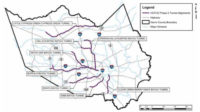Flood control projects in Harris County, Texas, are facing a $1.4-billion funding gap, and county officials are having to explore alternative funding opportunities or face construction delays.
Alan Black, director of operations for the Harris County Flood Control District, told ENR that all 181 of the county’s planned flood control projects in a nearly $5 billion program will get built one way or another, and none have been delayed so far. But county officials may have to pivot to different funding sources to keep projects on schedule after federal and state funding for the program came up short.
“Every single project is still moving forward. We haven’t run out of any money yet. So we’re going to continue to design and build every one of the projects,” Black says.
Among its strategies, county officials are looking at applying to a new FEMA disaster-mitigation program and requesting federal stimulus dollars. But the county is also developing a “Plan B” that could include raising property taxes and using toll road funds.
“We don’t view this as a shortfall. We view this as us continuing to seek the partnership opportunities that we’ve always said we would seek,” Black says. “And that is that from day one, it was a $5 billion program with a kick start of $2.5 billion in local funding.”
In 2018, exactly one year after Hurricane Harvey, county voters approved a $2.5 billion bond program to fund flood relief projects. Harris County had identified nearly $5 billion in flood control projects for the county, and the premise behind the bond program was that the county would invest $2.5 billion of its own money in these projects, and the other $2.5 billion would come from federal, state and local funding.
But at a March 9 meeting of the Harris County Commissioners Court, budget director David Berry informed commissioners that so far, the county has been able to secure only about $1.2 billion.
“The hope after Hurricane Harvey — that federal and state funds would really be focused on Harris County, where we saw the worst damage — has not altogether turned out to be true,” Berry told the Commissioners Court.
The flood control funding opportunity that has proved to be the “most frustrating,” Black says, involves the Texas General Land Office’s administration of U.S. Housing and Urban Development recovery money.
After the 2018 storm season that included hurricanes Harvey, Irma and Maria, Congress approved $66 billion in disaster relief funding to go to HUD, the U.S. Army Corps of Engineers and the Federal Emergency Management Agency. From that funding, the state gave $1 billion in HUD recovery funds directly to the city of Houston and another $1 billion to Harris County after Harvey.
“It was our belief that the distribution of those mitigation funds would follow the same model as some of the previous funds that had been distributed after Harvey,” Black says.
But instead, the state decided that instead of giving more money directly to the county, it would require cities, counties and local agencies to apply for grant money. The state limited each entity to three applications and capped each request at $100 million. Black says Harris County agencies have requested the maximum of $900 million and will find out this spring how much project funding the General Land Office will award.
In the meantime, Harris County is exploring other programs that award funding annually. One example Black points to is FEMA’s new Building Resilient Infrastructure and Communities, or BRIC program. The agency introduced the annual grant program in 2020 to provide pre-disaster mitigation funding annually to cities, states and counties.
Another funding opportunity, Black says, is the recently approved $1.9 trillion federal stimulus package, which includes $4 billion for the U.S. Economic Development Administration. The EDA was one of the federal agencies that provided relief funding after Hurricane Harvey and could potentially fund flood projects, Black says.
To supplement those efforts, the county is developing a “Plan B” in case it exhausts all of its other funding options. Potential “Plan B” strategies include the use of toll roll funds or raising property taxes in the flood control district, he says.
One concern about the lack of funding is how it might affect flood control work planned for economically depressed areas on the east side of the county, particularly the flood-prone Halls Bayou and Greens Bayou watersheds. Commissioner Rodney Ellis said at the meeting that the bond money was intended to help create equity in areas that have long faced funding disparities when it comes to flood protection.
“I do want to stress that we can pray for money from state and federal partners. We can lobby to get it. But if we don’t get it, it’s unacceptable. And in my judgment, we will all have blood on our hands because we will have lied,” Ellis says.
County officials say they will need to close the funding gap by the end of the year in order to avoid delays. “We’re not in a position, in my opinion, to press the brakes down hard on what we’re doing,” Berry told commissioners at the meeting. “But we are in a position where I think we need to start taking some action to address this funding.”





Post a comment to this article
Report Abusive Comment